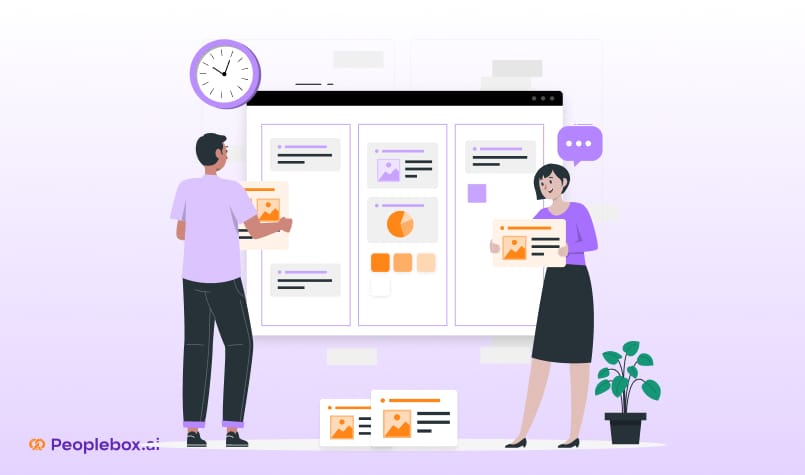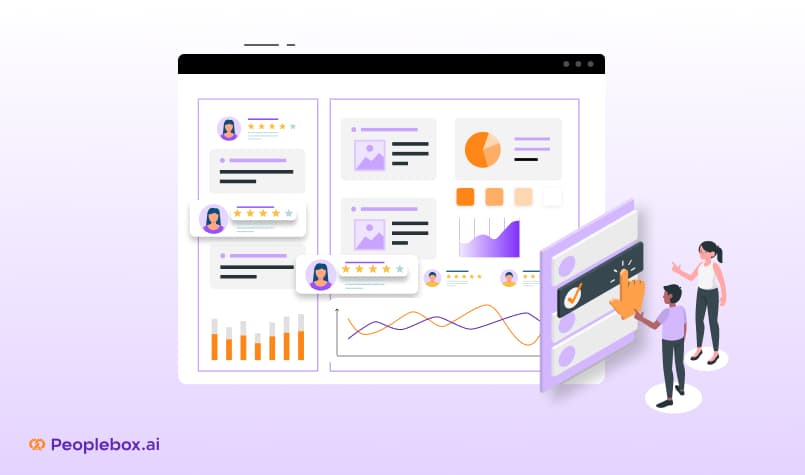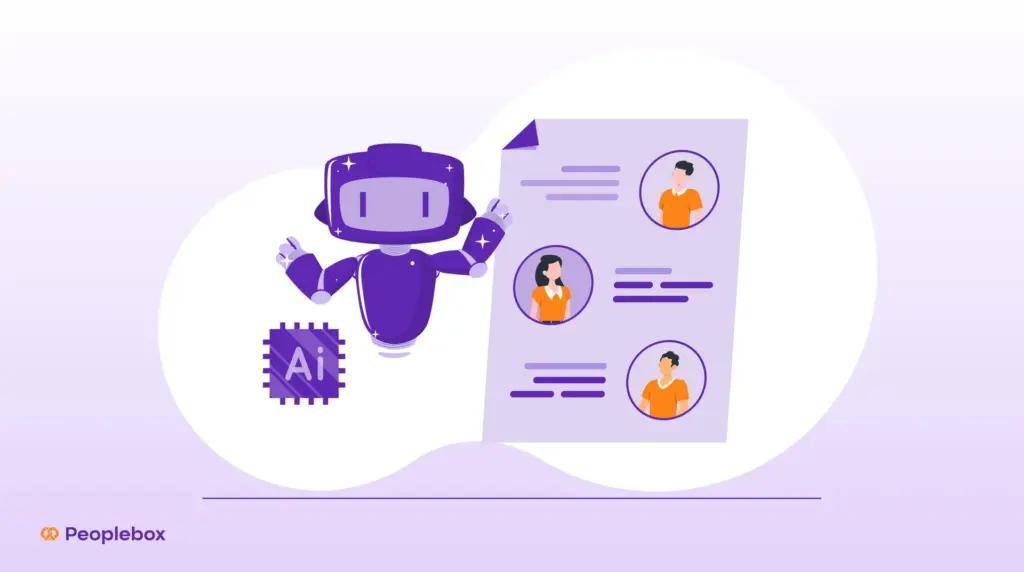Job competencies are changing the way companies find, grow, and manage talent. As an HR leader, you’ve likely hired candidates who looked great on paper, only to find them struggling a few months later. Often, the problem isn’t their technical skills but how they work with others, communicate, or solve problems.
These issues don’t just hurt productivity. They affect team morale, delay projects, and force managers to fix gaps that could have been caught sooner.
Competencies go beyond basic skills to show what really drives success—from strategic thinking to staying adaptable under pressure.
In this guide, we’ll show how to find, build, and use job competencies to create stronger teams and better business results.

What are Job Competencies?
Job competencies are a blend of skills, abilities, and knowledge that an individual employee should possess for enhanced performance and success in their role.
In simple words, it is ‘the capability of an individual to meet the requirements of a job.’
Do not confuse competencies with skills. While they may seem quite similar, they are two different terms. Skills tell you what types of abilities an employee needs to perform the role, and competency tells you how it is performed.
For example, the ability to use spreadsheet software is a skill, while data-driven decision-making is a competency.
Competencies can constitute two kinds of skills:
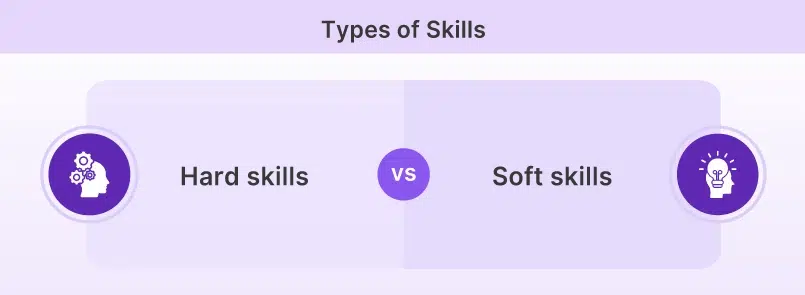
1. Hard Skills: Hard skills have two basic qualities: They are measurable and teachable. They are most often acquired through formal education, courses, and training.
Proficiency in programming languages or an understanding of Agile methodologies are classic examples of hard skills.
2. Soft Skills: Such skills are non-tangible and acquired over the years. They typically revolve around how effectively employees work with others. Examples of soft skills include communication skills, leadership, teamwork, adaptability, and problem-solving.
Reasons Why Job Competencies Matter
By establishing clear competencies for different roles, you can experience the following benefits:
| Importance of Job Competencies | |
| Smart hiring | Match the right talent to the right roles with precision |
| Peak performance | Set clear standards, drive exceptional results |
| Growth path | Enable skill development through structured training |
| Future-ready | Identify and groom tomorrow’s leaders today |
| Self-driven Tteams | Empower employees with clear advancement paths |
01 Serves as a Guideline for Recruiting the Most Suitable Candidates
Job competencies offer a framework that you can use to assess a candidate’s suitability for a role. In other words, it helps identify individuals who align with your company’s present needs and have the potential to contribute meaningfully to your organization from the word go.
02 Helps Create a High-Performing Workforce
When competencies are defined, employees are clear on the expectations and standards of performance. This clarity leads to a workforce that’s better equipped to meet both job-related and organizational-level goals.
Employees with the right competencies can also perform tasks efficiently, contributing to a more agile and competitive work environment.
“A skills-first culture is not just a trend; it’s a strategic imperative that fosters talent agility and ensures your workforce remains adaptable in the face of rapid change.”- Ria Jordan, CDP, GPHR, SHRM-SCP
03 Supports Employee Training and Development
Job competencies provide a pathway for employee development as they highlight the skills and knowledge needed for progression. Managers and employees can work together to address gaps through training and mentorship.
This structured approach helps employees grow within their roles, increasing job retention.
04 Helps in Succession Planning and Leadership Development
Through job competencies, you can identify and groom future leaders by tracking which employees possess the potential for higher responsibilities. This proactive approach to succession planning ensures that critical roles are always filled.
More importantly, your organization has timely access to competent, prepared individuals, thereby reducing risks associated with sudden departures.
05 Acts as a Motivation Driver for Employees
As we have highlighted earlier, competencies make expectations transparent. This enables employees to understand what they need to do to grow within the company. When employees see a clear path for advancement, along with support for skill development, they are more motivated to excel.

10 Common Types of Job Competencies at the Workplace
While there are plenty of specific job competencies associated with different roles, we are going to go through the ten most common types of competencies that are required for almost every role in an organization:
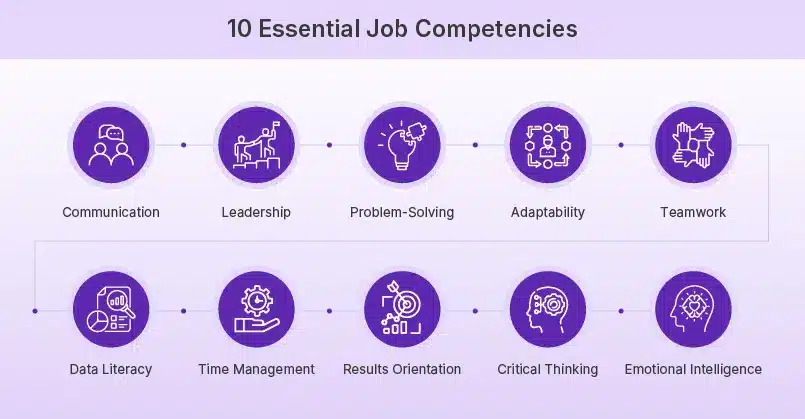
🗣️ Communication: Communicating Clearly Across All Levels
Effective communication is a foundational competency in any role. It creates clarity, reduces misunderstandings, and encourages collaboration.
Employees who possess this competency can convey ideas clearly, listen actively, and adapt their message to suit different audiences.

They can communicate with peers, managers, and clients with equal proficiency.
👨💼 Leadership: Guiding Teams Toward Shared Goals
Contrary to popular opinion, leadership competency is not restricted to just managerial or leadership roles. Employees at any level can display leadership by taking initiative or inspiring others. This competency is all about guiding others and making strategic decisions when the demand arises.
A good leader can create a sense of purpose and align within their teams to create a culture of collaboration and mutual respect.

⚙️ Problem-solving: Solving Complex Problems Systematically
An employee with this competency can solve challenges analytically and develop practical solutions. Such employees can identify issues, analyze options, and execute solutions, all in a systematic and efficient way.
This competency is particularly crucial in today’s dynamic work environments, where quick thinking can significantly impact project outcomes and customer satisfaction.

🔄 Adaptability: Navigating Change and Uncertainty
Highly adaptable Employees can adjust to new conditions and stay productive in times of change. They can learn new skills with great ease, shifting priorities when the need arises, adopting innovation proactively, and remaining resilient in the face of uncertainty.
Adaptable employees also contribute positively to change initiatives and support a culture of continuous improvement.

👬 Teamwork: Building Effective Collaborations
Teamwork competency is essential in any collaborative workplace. It involves working effectively with others and respecting diverse perspectives. Employees who excel in teamwork build trust, communicate openly, and work toward common goals.
Strong team players are also invested in the success of the group and their own individual performance.

📊 Data Literacy: Making Informed Decisions
Data literacy competency includes understanding basic statistical concepts, interpreting data visualizations, and using data-driven insights to support business decisions.
Data-literate employees know how to ask the right questions about data and can effectively translate data insights into actionable recommendations.

⏰ Time Management: Maximizing Productivity
Time management involves the ability to prioritize tasks, meet deadlines, and maintain a healthy work-life balance while delivering high-quality results.
Employees with strong time management skills consistently deliver results while avoiding burnout. They understand the importance of planning and can effectively balance urgent tasks with important long-term projects.

🎯 Results Orientation: Achieving Objectives
Results orientation is the ability to focus on outcomes and take necessary actions to achieve or exceed objectives. This competency involves setting clear goals, developing action plans, and maintaining high standards of performance throughout project execution.
These individuals take ownership of their deliverables. They consistently track progress, overcome obstacles, and ensure that results align with organizational objectives.

🔍 Critical Thinking: Analyzing and Evaluating Information
Critical thinking requires employees to question assumptions, consider alternative perspectives, and make decisions based on logical reasoning rather than emotional reactions.
Employees with strong critical thinking skills can identify patterns, question assumptions, and make well-reasoned decisions. They approach problems methodically and consider the implications of their decisions for both the short term and the long term.

🤝 Emotional Intelligence: Understanding and Managing Relationships
Emotional intelligence encompasses the ability to recognize, understand, and manage one’s own emotions while effectively responding to the emotions of others. This competency includes developing strong interpersonal relationships, showing empathy, and navigating complex social situations in the workplace.
Employees with high EQ create positive work environments and handle conflicts constructively.

Examples of Job Competencies for Different Roles
Let us now look at some job-specific competencies and the impact that an employee with such competencies has on the organization:
| Role | Competencies | Impact |
Human Resources Specialist | – Employee relations – Conflict resolution – Organizational development – Confidentiality | – Supports a positive work environment – Addresses employee needs – Ensures HR policy compliance. |
Project Manager | – Project planning – Risk management – Leadership – Stakeholder communication | – Enables effective resource management – Deadline adherence – Alignment with business goals |
Software Developer | – Coding proficiency – Problem-solving – Attention to detailTeamwork | – Facilitates clean coding – Effective troubleshooting – Strong collaboration with QA and product teams |
Sales Representative | – Persuasion – Customer relationship management – Resilience – Product knowledge | – Drives sales target achievement – Builds customer trust – Handles objections effectively |
Accountant | – Attention to detail – Proficiency in accounting software – Ethics and integrity – Data management | – Ensures financial accuracy – Ensures compliance with financial regulations – Supports strategic planning |
How to Develop Job Competencies at the Workplace?
While many organizations recognize the importance of job competencies, the real challenge lies in implementing an effective development strategy.
Here’s your step-by-step guide to transforming potential into performance and building a workforce that’s ready for tomorrow’s challenges.
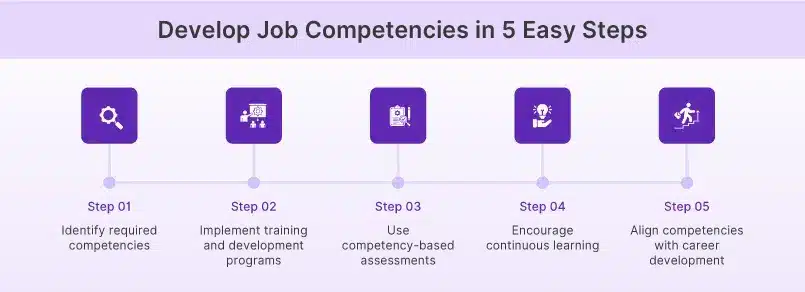
Step 1: Identify Required Competencies
Every role has unique competencies. So, for each role, figure out the essential skills and knowledge necessary for success. The best way to go about this is by collaborating with department heads and team leads. They will help you identify specific competencies that align with job responsibilities.
You can also find out what others in your industry are doing and use that information to build your competency list. This list will form the foundation for your competency development plan.
Step 2: Implement Training and Development Programs
Once the key competencies are identified, start designing training programs for each competency area. This can include a mix of workshops, on-the-job training, online courses, or even mentorship programs.
If needed, bring in third-party vendors to train your team, as you might not have in-house experts for all the competencies. You can also encourage team members to attend certification programs, which can give you a better idea about whether the employees have successfully acquired the competencies necessary to excel in their roles.
Step 3: Use Competency-Based Assessments
Conduct regular competency-based assessments for all the employees. Such regular assessments will not only help measure an employee’s competency level but also provide insights into areas of improvement from time to time.
You could conduct online skills tests, performance reviews, or simply share feedback from peers and managers. This will allow for a more targeted approach to development and help track employee progress over time.
Step 4: Encourage Continuous Learning
Competency development is an ongoing process. Not every employee will be enthusiastic about proactively keeping themselves updated and sharpening their competencies from time to time. So, you must constantly encourage employees and highlight the importance of continuous learning.
Provide them with access to necessary resources like online courses or conduct regular knowledge-sharing sessions. This will help them keep up with changing industry standards and ensure that their skills remain relevant.
Step 5: Align Competencies with Career Development
As a final step, remember to link the competencies with the career advancement plans for different roles. This will help employees set goals and outline clear steps needed for promotion or lateral moves within the organization. This alignment enhances motivation and builds a robust talent pipeline with minimal attrition.
🥨 How can Peoplebox help with Job Competency Management?
Peoplebox provides an ideal platform for goal-setting, continuous feedback, and performance tracking, all of which are key ingredients to achieving various competencies. Here’s how Peoplebox can benefit your organization:
- Comprehensive Competency Management: Our centralized system tracks and organizes competencies across your organization. You can import competencies easily via CSV, categorize them by theme, and map them to specific teams and positions.

- Clear Growth Paths & Career Development: Our platform helps employees visualize their career progression through detailed position mapping and competency requirements. Employees can see their current role, potential next positions, and the competencies needed to advance.
- Performance Tracking & Assessment: Managers and leads can monitor competency development through visual charts and detailed scorecards. Employees can compare self-assessments with manager ratings and track progress across different review cycles.
- Structured Role Requirements: You can define and manage competency requirements by team, track, and position levels. It is also possible to set specific proficiency levels and weightage for each competency, ensuring clear skill expectations across roles.
- Data-Driven Development Planning: Within Peoplebox, you can create Individual Development Plans (IDPs) based on competency assessments. This will help employees focus on the right skills for their current and future roles.
To know more about Peoplebox and how it can help manage job competencies, book a demo now.

